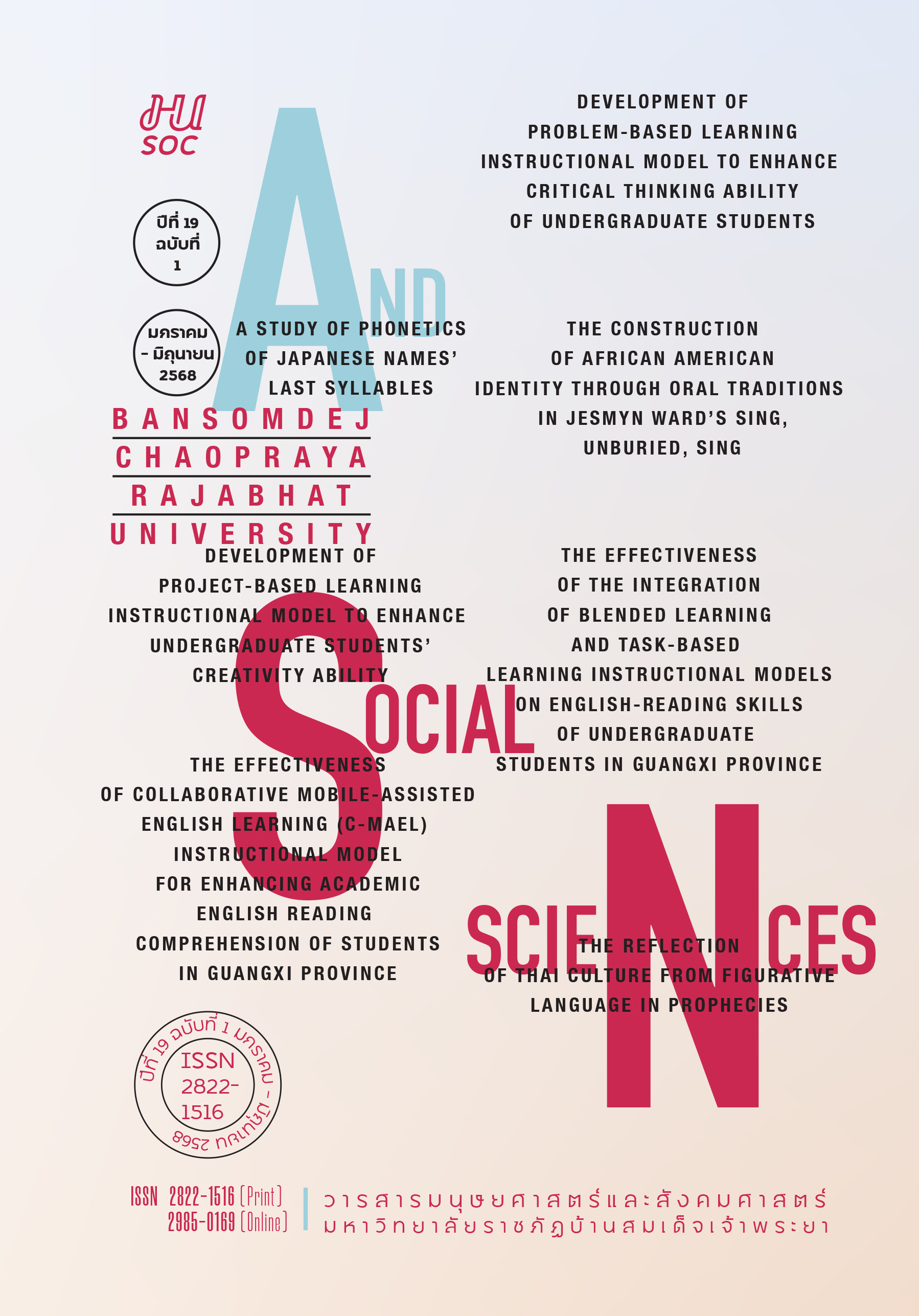การมีส่วนร่วมในการพัฒนาหลักสูตรต้านทุจริตศึกษาของนักศึกษาชั้นปีที่ 1 มหาวิทยาลัยราชภัฏบ้านสมเด็จเจ้าพระยา
คำสำคัญ:
การมีส่วนร่วม, การพัฒนาหลักสูตร, หลักสูตรต้านทุจริตศึกษาบทคัดย่อ
การวิจัยนี้มีวัตถุประสงค์เพื่อ 1) ศึกษาสถานการณ์ปัจจุบันเกี่ยวกับการมีส่วนร่วมในการพัฒนาหลักสูตรต้านทุจริตศึกษา 2) ศึกษาปัญหาและข้อเสนอแนะจากผู้บริหาร อาจารย์ และผู้มีส่วนได้ส่วนเสียภายนอกในการส่งเสริมการพัฒนาหลักสูตรต้านทุจริตศึกษา และ 3) ศึกษาแนวทางพัฒนาและส่งเสริมหลักสูตรต้านทุจริตศึกษาแบบมีส่วนร่วม ประชากรที่ศึกษาแบ่งเป็น 3 กลุ่ม ได้แก่ 1) นักศึกษาชั้นปีที่ 1 ที่ลงทะเบียนเรียนในรายวิชาความเป็นพลเมือง จำนวน 565 คน 2)ผู้บริหารฝ่ายวิชาการและอาจารย์ที่เกี่ยวข้องกับกับการพัฒนาหลักสูตรต้านทุจริตศึกษา รวม 15 คน และ 3) ผู้มีส่วนได้ส่วนเสียจากหน่วยงานภายนอก 4 แห่ง จำนวน 44 คน การสุ่มตัวอย่างแบ่งเป็น 2 ระยะคือ ระยะที่ 1 ใช้การสุ่มตัวอย่างแบบง่าย และการสุ่มแบบแบ่งชั้น โดยเลือกนักศึกษา 300 คน จาก 6 หมู่เรียน และระยะที่ 2 ใช้การสุ่มแบบเฉพาะเจาะจงเลือกผู้บริหารและอาจารย์ 6 คน รวมถึงผู้มีส่วนได้ส่วนเสีย 7 คน สำหรับการสัมภาษณ์เชิงลึก เครื่องมือที่ใช้ในการวิจัยประกอบด้วย แบบสอบถาม และแบบสัมภาษณ์กึ่งโครงสร้างซึ่งผ่านการตรวจสอบความเที่ยงตรงเชิงเนื้อหา โดยมีค่าดัชนีความสอดคล้องระหว่างข้อคำถามกับวัตถุประสงค์ (IOC) อยู่ในช่วง 0.60-0.80 โดยผู้เชี่ยวชาญ 3 ท่านในการตรวจพิจารณาข้อคำถาม แล้วนำผลการตรวจสอบมาคำนวณหาค่าดัชนีความสอดคล้องระหว่างข้อคำถามกับวัตถุประสงค์ที่ต้องการวัดประเมิน ผลการศึกษา พบว่า 1) สถานการณ์ปัจจุบันเกี่ยวกับการมีส่วนร่วมในการพัฒนาหลักสูตรต้านทุจริตศึกษาพบว่า โดยรวมทุกด้านอยู่ในระดับมาก (x̅ = 3.75, S.D. = 1.07) ด้านที่มีค่าเฉลี่ยสูงสุดคือ การรับผลประโยชน์อยู่ในระดับมาก (x̅ = 3.77, S.D. = 1.06) รองลงมาคือ การวางแผนอยู่ในระดับมาก (x̅ =3.75, S.D. = 1.07) รองลงมาคือการประเมินผลอยู่ในระดับมาก (x̅ = 3.74, S.D. = 1.05) และด้านที่มีค่าเฉลี่ยต่ำสุด คือ การตัดสินใจอยู่ในระดับมาก (x̅ = 3.72, S.D. = 1.07) และนักเรียนมีส่วนร่วมในการพัฒนาแหล่งเรียนรู้และกิจกรรมส่งเสริมหลักสูตร แต่ต้องปรับปรุงความโปร่งใสในการตัดสินใจและเพิ่มโอกาสให้นักศึกษาแสดงความคิดเห็น 2) ปัญหาและข้อเสนอแนะจากผู้บริหาร อาจารย์และผู้มีส่วนได้ส่วนเสียภายนอกในการส่งเสริมการพัฒนาหลักสูตรต้านทุจริตศึกษา พบว่า มีปัญหา 4 ด้าน คือ ด้านการวางแผน พบว่า ยังขาดการเผยแพร่ข้อมูลที่สำคัญของมหาวิทยาลัย เช่น นโยบายและงบประมาณยังไม่ชัดเจน ควรมีวางแผนการใช้ช่องทางประชาสัมพันธ์ที่หลากหลาย ด้านการตัดสินใจดำเนินการพบว่า กิจกรรมในหลักสูตรต้านการทุจริต นักศึกษาไม่เข้าร่วมกิจกรรมรณรงค์อย่างเพียงพอ ส่งผลให้เกิดความตระหนักรู้ถึงผลเสียของการทุจริตน้อย มหาวิทยาลัยควรจัดกิจกรรมส่งเสริมสิทธิประชาชนในการเฝ้าระวังการทุจริตที่เกิดขึ้นในสังคมปัจจุบันมากขึ้น และด้านการมีส่วนร่วมในการรับผลประโยชน์และการประเมินผล พบว่า ยังขาดการพัฒนาเนื้อหาที่ช่วยสร้างความรู้เกี่ยวกับการปกป้องตนเองและการรับรู้ถึงสิทธิและหน้าที่ของตนเอง รวมถึงการขาดกลไกในการฝึกทักษะป้องกันตนเอง ส่งผลให้ผู้เรียนไม่มีความพร้อมในการต่อต้านการทุจริต มหาวิทยาลัยจึงควรมีมาตรการ ที่ชัดเจนและสร้างวัฒนธรรมในการไม่ยอมรับการทุจริต โดยส่งเสริมให้ทุกฝ่ายมีส่วนร่วมในการแก้ไขปัญหานี้เพื่อลดโอกาสในการเกิดปัญหาเดิมซ้ำ ๆ และไม่มองเรื่องการทุจริตเป็นเรื่องปกติไว้ในรายวิชาที่พัฒนาขึ้นจากหลักสูตรต้านทุจริตศึกษา 3) แนวทางพัฒนาและส่งเสริมหลักสูตรต้านทุจริตศึกษาแบบมีส่วนร่วม พบว่า มี 3 ประเด็น คือ การมีส่วนร่วมในด้านการบริหารจัดการหลักสูตรต้านทุจริตศึกษา พบว่า มหาวิทยาลัยควรเปิดโอกาสให้นักศึกษา ศิษย์เก่า ผู้มีส่วนได้ส่วนเสียทั้งภายในและภายนอกมหาวิทยาลัยเข้ามามีบทบาทในการออกแบบหลักสูตรเพื่อเสริมสร้างคุณธรรมจริยธรรมให้กับนักศึกษา การมีส่วนร่วมในด้านงบประมาณ พบว่า มหาวิทยาลัยควรจัดสรรงบประมาณอย่างเพียงพอเพื่อสนับสนุนการเข้ามามีส่วนร่วมในหลักสูตรอย่างมีประสิทธิภาพ ส่งผลให้นักศึกษาได้รับประโยชน์จากการเรียนรู้ที่สามารถนำไปใช้ในชีวิตจริงพร้อมทั้งส่งเสริมคุณภาพชีวิตของเยาวชนและตอบสนองความต้องการของชุมชนในการสร้างสังคมที่โปร่งใสและสร้างสังคมให้มีความเป็นอยู่ที่ดีและการมีส่วนร่วมในด้านการบริหารงานทั่วไป พบว่า มหาวิทยาลัยควรเน้นการสร้างสภาพแวดล้อมที่เอื้อต่อการมีส่วนร่วมในการวางแผนและตัดสินใจการจัดกิจกรรมต่าง ๆ โดยผู้บริหารและอาจารย์สนับสนุนการมีส่วนร่วมของผู้มีส่วนได้ส่วนเสียทั้งภายในและภายนอก เพื่อให้ทุกคนสามารถใช้ความรู้และความสามารถได้ตามสิทธิ์ความเป็นพลเมืองในระบอบประชาธิปไตย
เอกสารอ้างอิง
Anti-Corruption Education Bureau, Office of the NACC. (2021). Report on Monitoring and Advisory Services for Driving the Anti-Corruption Education Curriculum under the Anti-Corruption Education Technology (AC EdTech) Project, Fiscal Year 2021. [In Thai]
Anti-Corruption Education Curriculum. (2018). Anti-Corruption Education Bureau, National Anti-Corruption Commission. Office of the National Anti-Corruption Commission. [In Thai]
Bansomdejchaopraya Rajabhat University, Office of Promotion and Registration. (2023). Student information. Retrieved August 8, 2023. https://mis2.bsru.ac.th [In Thai]
Buasan, R. (1997). Evaluation of evaluative research projects/Rattana Buasan; printed by Phimlak. Compact Print Company Limited. [In Thai]
National Education Act. (1999). Sections 5 and 39. Royal Gazette, Volume 116, Part 123 G, Retrived December 19, 2002. https://www.ratchakitcha.soc.go.th/DATA/PDF/2542/A/074/1.PDF [In Thai]
Panjiang, P., & Thammarat, S. (2021). A Study of Parents’ Participation in Educational Management of Khaochaison school, Amphur Khaochaison, Phattalung Province, Phatthalung Secondary Educational Service Area Office (pp. 1220 - 1234). Hatyai National and International Conference, Hatyai University. [In Thai]
Sangtong, A. (2023). The School Curriculum Development of Watjantrawart (Sukprasarnrat) School. Journal of Educational Administration, 13(1), 97-111. [In Thai]
Supayong, P. (2020). The Development of Guidelines for Promoting Parent’s Participation in School Administration at Ban Klang School, Mae Salong Nok Sub-District, Mae Fah
Luang District, Chiang Rai Province. [Master Dissertation, Chiang Mai Rajabhat University]. [In Thai]
Ungkanawin, K., & Pachanasavan, A. (2020). Participation in Educational Administration of Educational Personnel Huathanon School, Phanatnikhom District, Chonburi Province. Journal of Multidisciplinary in Humanities and Social Sciences. 3(1), 13-28. [In Thai]
Wattanakul., P. & Loyvirat., T. (2020). A Study of Youth Network Development Models to Promote Integrity and Anti-Corruption Values in Mahasarakham Province. (Research Report). Mahasarakham Rajabhat University. [In Thai]
Wongthanavasu, S., Ruangthamsing, C., Ketchatturat, J., & Thamviset, W. (2022). An Evaluation of the Implementation of the Anti-Corruption Education for the Basic Education
and the Higher Education Levels in Thailand. Journal of Modern Learning Development, 7(3), 83 – 99. [In Thai]
Yamane, T. (1973). Statistics: An introductory analysis. (3rd ed.). Harper & Row.
ดาวน์โหลด
เผยแพร่แล้ว
รูปแบบการอ้างอิง
ฉบับ
ประเภทบทความ
สัญญาอนุญาต
ลิขสิทธิ์ (c) 2024 คณะมนุษยศาสตร์และสังคมศาสตร์ มหาวิทยาลัยราชภัฏบ้านสมเด็จเจ้าพระยา

อนุญาตภายใต้เงื่อนไข Creative Commons Attribution-NonCommercial-NoDerivatives 4.0 International License.



